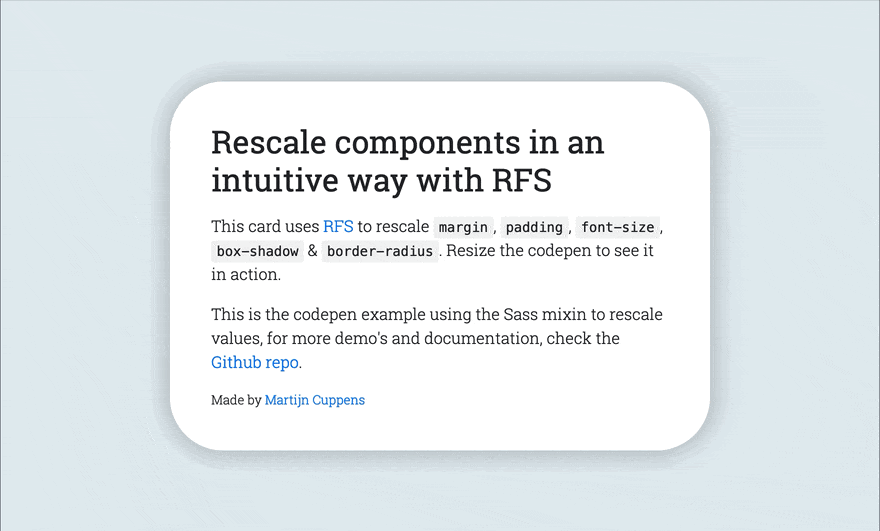
RFS is a unit resizing engine which was initially developed to resize font sizes (hence its abbreviation for Responsive Font Sizes). Nowadays RFS is capable of rescaling basically every value for any css property with units, like margin, padding, border-radius or even box-shadow.
The mechanism automatically calculates the appropriate values based on the dimensions of the browser viewport. It's available in one of your favourite preprocessors or postprocessor: Sass, Less, Stylus or PostCSS.
RFS




Installation
RFS can be installed using a package manager (recommended):
- npm:
npm install rfs - yarn:
yarn add rfs
Copy/paste (not recommended):
The source files can also be downloaded manually and used in a project. This method is not recommended because you
lose the ability to easily and quickly manage and update RFS as a dependency.
Usage
Input
Sass (.scss syntax)
@import "node_modules/rfs/scss";
:root {
--spacer-lg: rfs(2.5rem);
}
.title {
margin-bottom: var(--spacer-lg);
padding-top: rfs(.5rem) !important;
font-size: rfs(4rem);
}
Sass (.sass syntax)
@import "node_modules/rfs/sass"
:root
--spacer-lg: rfs(2.5rem)
.title
margin-bottom: var(--spacer-lg)
padding-top: rfs(.5rem) !important
font-size: rfs(4rem)
PostCSS
Have a look at the examples folder to find examples on how your PostCSS setup can be configured.
:root {
--spacer-lg: rfs(2.5rem);
}
.title {
margin-bottom: var(--spacer-lg);
padding-top: rfs(.5rem) !important;
font-size: rfs(4rem);
}
Less
Using unnamed lookups.
@import "node_modules/rfs/less";
:root {
--spacer-lg: .rfs(2.5rem)[];
}
.title {
margin-bottom: var(--spacer-lg);
padding-top: rfs(.5rem)[] !important;
font-size: rfs(4rem)[];
}
Stylus
@import "node_modules/rfs/stylus";
:root {
--spacer-lg: rfs(2.5rem);
}
.title {
margin-bottom: var(--spacer-lg);
padding-top: rfs(.5rem) !important;
font-size: rfs(4rem);
}
Generated css
:root {
--spacer-lg: min(2.5rem, calc(1.375rem + 1.5vw));
}
.title {
margin-bottom: var(--spacer-lg);
padding-top: .5rem !important;
font-size: min(4rem, calc(1.525rem + 3.3vw));
}
Fluid rescaling in action
The following example shows the effect of RFS on paddings, box-shadows & font-sizes:

Visualisation
If you wonder how the values are rescaled, wonder no more and stare at this graph which might clarify things a bit:

Each color represents another value being rescaled. For example:
.title {
font-size: rfs(40px);
}
This is the green line. A font size of 40px stays 40px in viewports with a size larger than 1200px. Below 1200px, the font size is rescaled and at viewport of 360px, the font size is about 27px. Note that every font size is generated in a combination of rem and vw units, but they are mapped to px in the graph to make it easier to understand.
Configuration
RFS works out of the box without any configuration tweaks, but if you feel the urge to go loco and fine tune the way values are rescaled, you can:
Base value (unit in px or rem)
- SCSS, Sass & Stylus:
$rfs-base-value - Less:
@rfs-base-value - PostCSS:
baseValue
The option will prevent the value from becoming too small on smaller screens. If the font size which is passed to RFS is smaller than this value, no fluid rescaling will take place.
Default value: 1.25rem
Unit (px or rem)
- SCSS, Sass & Stylus:
$rfs-unit - Less:
@rfs-unit - PostCSS:
unit
The output value will be rendered in this unit. Keep in mind configuring this value to px will disable the ability for users to change the the font size in their browser.
Default value: rem
Breakpoint (in px, em or rem)
- SCSS, Sass & Stylus:
$rfs-breakpoint - Less:
@rfs-breakpoint - PostCSS:
breakpoint
Above this breakpoint, the value will be equal to the value you passed to RFS; below the breakpoint, the value will dynamically scale.
Default value: 1200px
Factor (number)
- SCSS, Sass & Stylus:
$rfs-factor - Less:
@rfs-factor - PostCSS:
factor
This value determines the strength of font size resizing. The higher the factor, the less difference there is between values on small screens. The lower the factor, the less influence RFS has, which results in bigger values for small screens. The factor must be greater than 1.
Default value: 10
Rem value (number)
- SCSS, Sass & Stylus:
$rfs-rem-value - Less:
@rfs-rem-value - PostCSS:
remValue
The value of 1rem in px. The value of 1rem is typically 16px but if the font size is changed for html the value of 1rem changes. This variable can be used to change the default value but be careful with it because changing it could lead to unexpected behaviour, for example if additional CSS is loaded which expects 1rem to be 16px.
Default value: 16
Two dimensional (boolean)
- SCSS, Sass & Stylus:
$rfs-two-dimensional - Less:
@rfs-two-dimensional - PostCSS:
twoDimensional
Enabling the two dimensional option will determine the value based on the smallest side of the screen with vmin. This prevents values from changing if the device toggles between portrait and landscape mode.
Default value: false
Best practices
- Don't set RFS on the
html element, because this influences the value of rem and could lead to unexpected results. - Always set your line-heights relative (in
em or unitless) to prevent interline issues with font sizes.
Browser support
RFS is supported by all browsers that support CSS math functions. If you need support for legacy browsers, check out the v9 version which uses media queries.
Demos
Versions
Current version (v10)
In v10, rfs is a function which outputs the css min() function.
Version 9
In v9, rfs is a mixin in Sass, Less & Stylelint. This version uses a media query with min-width (mobile first approach). v9 is used in Bootstrap 5.
Version 8
In v8, rfs only supported font sizes. This version uses a max-width media query. v8 is used in from Bootstrap 4.3.
Creator
Martijn Cuppens
Copyright and license
Code released under the MIT license.







